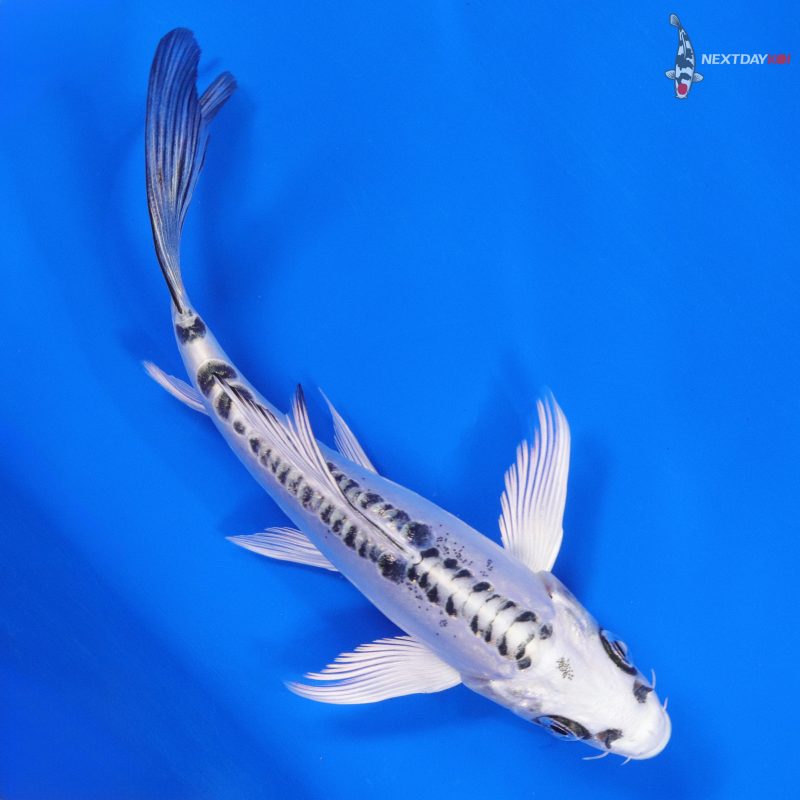The history of Koi fish can be traced back to the early 8th century in Japan, but Doitsu Koi, or scaleless Koi, are relatively new to the industry. Doitsu Koi are Koi with little or no scales. This type of Koi has become increasingly popular among hobbyists and is now available in every Koi variety. Are you wondering if Doitsu Koi is a good choice for your pond? Here’s everything you need to know about this unique variety of fish.
History of Doitsu Koi
The origin of Doitsu Koi is thought to be the result of an accidental genetic mutation in fish hundreds of years ago. This specific mutation is most common in a group of fish called Teleosts, which includes carp. In the early 1900s, scaleless carp were selectively bred in Germany as a food source. The lack of scales saved time while preparing a meal because it eliminated the need to descale the fish before cooking. These scaleless carp were eventually imported to Japan and crossbred with Japanese scaled Koi and became known as Doitsu Koi. “Doitsu” is the Japanese word for “Deutsch,” or German.
Types of Doitsu Koi
As previously mentioned, Doitsu Koi have little to no scales. The lack of scales paired with sharp, bright colors and beautiful patterns make these fish stand out in a pond. There are three different types of Doitsu Koi–Kawi Goi, Kagami Goi, and Yoroi Goi–which are categorized by pattern and the number of scales.
Kawi Goi
Kawi Goi, also known as leather Koi, are either entirely scaleless or display a row of scales down the back on either side of the dorsal fin. These scales tend to be small and should be symmetrical on both sides and evenly spaced.
Kagami Goi
Kagami Goi, also known as mirrored or striped Koi, are a type of Doitsu Koi with a row of scales on the dorsal and ventral lines. The scales should start at the head, run to the tail, and be unbroken and uniform.
Yoroi Goi
Yoroi Goi, also called Armor Patterned, have random and irregularly sized scales all over the body. Symmetry and balance are ideal, as this pattern can appear messy otherwise.
What To Look For
The guidelines for choosing a good quality Doitsu Koi are very similar to any other type of Koi, though there are a few differences. While there are some standard guidelines for choosing a high-quality Doitsu Koi, the choice is yours at the end of the day. Unless you plan on showing your Koi, there’s no reason to disregard your personal preferences. Choose a fish you’d love to see in your pond. That said, here are a few general tips for what to look for when picking a Doitsu Koi.
Body
The first thing to consider when choosing a Doitsu Koi is its body. The fish should have a uniform torpedo-shaped body on both sides and proportional, symmetrical fins and head. Doitsu Koi tend to have fuller, thicker bodies than other Koi. Check the fins and body for any abnormalities or signs of illness.
Scales and Skin
If any scales are present, symmetry is key. Regardless of the type of Doitsu Koi, scales should be balanced and uniform and mirror each other on each side. Misplaced or randomly placed scales, especially on the belly or sides of the body, are not preferable. Scales should neatly line up and be consistent in size.
Color and Pattern
The exact guidelines for color and pattern depend on the variety. Generally, though, colors and patterns should be symmetrical and balanced. The depth, quality, and consistency of the color are also significant. The lines between different colors should be well-defined, without any colors bleeding into others. For metallic varieties, be sure to check the skin’s quality, shine, and vibrancy.
Are Doitsu Koi Right For Me?
While some people aren’t a fan of the scaleless appearance, it’s difficult to deny that Doitsu Koi are unique and beautiful, making them popular among many hobbyists. Aside from the lack of scales, a few other traits set Doitsu Koi apart from their scaled cousins. Doitsu Koi tend to grow more quickly, and females reach sexual maturity earlier. However, it should be noted that the lack of scales does give Doitsu Koi a few disadvantages. Due to the lack of protective scales, they tend to be less resistant to disease, infections, and sunburn. Their life expectancy is also not as long as scaled Koi. Despite this, Doitsu Koi continue to grow in popularity and are a great way to add variety and beauty to your pond.
Are you ready to add a Doitsu Koi to your backyard pond? Shop our full selection of Koi and Goldfish today.


what are the .most common colors
Hi Luther,
Blues, oranges, yellows, and silvers are all fairly common colors in the doitsu Koi. However, almost any of the Koi varieties seen today can be Dotisu (scaleless).
Would love to see beautiful Koi and have the ability to purchase without problems!